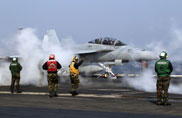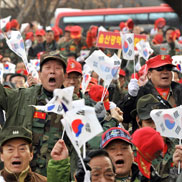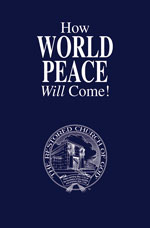 Chung Sung-Jun/Getty Images
Chung Sung-Jun/Getty Images
Article
Learn the why behind the headlines.
Subscribe to the Real Truth for FREE news and analysis.
Subscribe NowOn Nov. 23, 2010, North Korea fired artillery upon Yeonpyeong Island in the Yellow Sea, just 75 miles west of Seoul, shelling a marine base and a civilian village, setting several houses ablaze, injuring 18 troops and three civilians, and killing two South Korean marines and two civilians. A day earlier, Seoul had refused North Korea’s demand to halt military exercises in the area.
BBC News reported, “Pyongyang claims that it returned fire after South Korean marines on the island opened fire first, refusing to cease even when the North protested via telephone (itself, an unusual step).”
Despite a mutually declared ceasefire in 1953, North and South Korea remain technically at war.
Der Spiegel described this latest incident: “The most serious flare-up of violence since the end of Korean hostilities in 1953 has set Western teeth on edge and spurred a round of diplomatic head-scratching.” The editorial then asked, “What does North Korea want?”
Pyongyang remains defiant, warning that joint United States-South Korean military exercises, such as those that took place 70 miles from the latest bombing, could push the Korean Peninsula to the brink of war.
 Lee Jong-Geun-Korea-Pool/Getty Images
Lee Jong-Geun-Korea-Pool/Getty ImagesEight months earlier, in late March, a South Korean warship traveling near disputed waters mysteriously split in two and sank, killing 46 sailors. An international investigation concluded that a North Korean submarine had torpedoed the ship, which Pyongyang vehemently denied. South Korea petitioned the United Nations to condemn North Korea. The UN Security Council condemned the sinking, but did not blame the North Korean government. It is believed that China blocked attempts to blame Pyongyang.
Lately, relations had begun to improve between the North and South, with Pyongyang allowing South Koreans to meet with family members living in the North, and Seoul sending rice to its northern neighbor for the first time in two years.
 Jung Yeon-Je/AFP/Getty Images
Jung Yeon-Je/AFP/Getty ImagesWashington, Seoul React
The White House is calling on the international community to pressure North Korea. U.S. President Barack Obama told Barbara Walters of ABC News, “We strongly condemn the attack and we are rallying the international community to put pressure on North Korea.”
According to The Associated Press, South Korea said it would strengthen its forces in the disputed waters, while Pyongyang warned of more military strikes if the South encroached on the maritime border by “even 0.001 millimeter.”
Germany reaffirmed its support of South Korea and condemned North Korea’s shelling “in the strongest possible terms” (Der Spiegel). A spokesman for German Chancellor Angela Merkel told reporters, “North Korea is endangering peace in the region with these attacks.”
The United Kingdom also publicly condemned North Korea.
Elsewhere, China’s Foreign Ministry spokesman Hong Lei expressed concern, urging both Pyongyang and Seoul to “do more to contribute to peace and stability in the region” (BBC News).
Past Border Incidents
In the last 10 years, the North Korean government has intruded upon the North-South border and engaged in numerous other controversial incidents, as documented in the Congressional Research Service:
• Feb. 1, 2000: In Yanbian, China, two North Korean agents kidnap a South Korean-American citizen, according to South Korea’s National Intelligence Service.
• Oct. 2000: Pyongyang warns that if Seoul attempts to brand the North as sponsoring terrorism in regard to the 1983 terrorist bombing in Rangoon, Myanmar, this would amount to a provocation against North Korea.
• April 9, 2001: North Korean patrol boats briefly enter South Korean waters, and retreat after being challenged by the South Korean Navy. Another border breach is repeated the next day. Similar breaches occur February 5 and March 3.
• May 27, 2001: Breaching the contested Northern Limit Line (NLL) northwest of Paekryung Island in the Yellow Sea, a North Korean patrol boat stays for 47 minutes before returning to the North.
“North Korea does not recognize the western maritime border drawn unilaterally by the U.N. at the close of the conflict, and the Koreas have fought three bloody skirmishes there in recent years. But this clash follows months in which tensions have steadily risen to their worst levels since the late 1980s, when a confessed agent for North Korea bombed a South Korean jetliner, killing all 115 people aboard” (AP).
To prevent naval clashes off the Korean Peninsula’s west and east coasts, UN Command drew a maritime border—the NLL—at the end of the 1950-53 Korean War, weeks after the armistice between the communist North and democratic South was signed. The truce did not directly mention sea borders. North Korea took issue with the NLL in 1973, when it began violating the sea border in dispute of its validity. A 1991 agreement reaffirmed non-aggression and recognized the political sovereignty of both North and South.
In the 1990s, Pyongyang once again disputing the NLL, claimed its border should lie far south. A North Korean patrol boat violated the NLL in 1999 by as much as six miles, returning home after a deadly gunfight. South Korea says that the violation took place as North Korea cracked down on Chinese fishing boats operating nearby.
• June 4, 2001: The Korea Herald reports that three North Korean cargo vessels crossed into South Korea’s territorial waters, returning to international waters the next day after being challenged by South Korean naval vessels.
• July 6, 2001: A North Korean patrol boat crosses the NLL by two nautical miles and stays for some 40 minutes before returning to territory.
• Sept. 17, 2001: During Japanese Prime Minister Junichiro Koizumi’s summit in Pyongyang with Kim Jong Il, the North Korean leader apologizes for his country having kidnapped 11 Japanese citizens in the 1970s and 80s.
• Nov. 18, 2001: A North Korean patrol boat crosses the NLL, intruding almost two nautical miles into South Korean waters for 36 minutes.
• Nov. 27, 2001: North Korean soldiers fire three rounds at a South Korean guard post, leading soldiers from the South to respond with gunfire. No one is injured.
• Dec. 22, 2001: Japan’s Coast Guard chases and exchanges gunfire with a North Korean vessel—reportedly a “spy ship”—after it ignores a warning to stay out of Japan’s 200 nautical mile exclusive economic zone.
• Jan. 5, 2002: A North Korean patrol boat briefly infiltrates South Korean waters off Yeonpyeong island.
• March 13, 2002: The Guinea-Bissau Navy discovers a stash of submachine guns and ammunition aboard the North Korean ship Golden Like, which manages to escape.
• June 29, 2002: North Korean patrol boats cross the NLL and fire upon a South Korean patrol boat. Four South Koreans and an undetermined number of North Koreans are killed.
• Oct. 17, 2002: The U.S. State Department reveals that during meetings in Pyongyang, the North Korean government admitted its pursuit of a nuclear weapons development program.
• Oct. 22, 2002: Under pressure to scrap its nuclear weapons program, Pyongyang warns the U.S. that North Korea will take unspecified “tougher counteraction” if Washington does not accept talks on the issue.
• Dec. 11, 2002: Allied forces stop a North Korean ship in the Persian Gulf en route to Yemen and find it to be secretly carrying Scud missiles. The ship is released after Yemen confirms the missiles are for its army.
• Dec. 26, 2002: North Korea moves 1,000 nuclear fuel rods into the Yongbyon nuclear power plant.
• Jan. 10, 2003: North Korea announces it will immediately withdraw from the Nuclear Nonproliferation Treaty because the United States “most seriously threatened” the country.
• Jan. 11, 2003: The North Korean Ambassador to China says Pyongyang no longer feels bound by the 1999 missile test moratorium.
• Feb. 5, 2003: North Korea announces it reactivated its five-megawatt nuclear reactor at Yongbyon, enabling it to produce enough material for a nuclear bomb in a year.
• Feb. 18, 2003: Claiming a blockade against it would violate Article 15 of the armistice, North Korea accuses the U.S. of plotting an attack against it, and threatens to abandon the 1953 armistice if Washington imposes trade sanctions.
• Feb. 19, 2003: A North Korean fighter jet briefly crosses seven miles into South Korean airspace. In response, the South Korean air force sends six fighter planes and puts ground-to-air missiles on alert.
• Feb. 24, 2003: North Korea test fires a short-range anti-ship missile into the Sea of Japan just a few hours before a ceremony inaugurating South Korea’s newly elected president.
• March 2, 2003: In international airspace over the Sea of Japan, four North Korean fighter jets intercept a U.S. Air Force reconnaissance plane.
• March 10, 2003: North Korea fires a Silkworm ground-to-ship nonballistic missile into the Sea of Japan.
• April 10, 2003: North Korea withdraws from the Non-Proliferation Treaty.
• May 29, 2003: A U.S. lawmaker reports that during his visit to North Korea, leaders there “admitted to having nuclear capability” as well as trying to “expand their nuclear production program.”
• July 8, 2003: While meeting in New York, the North Korean Ambassador to the United Nation tells the U.S. State Department’s envoy for North Korean affairs that Pyongyang finished reprocessing all 8,000 spent nuclear fuel rods stored at its Yongbyon complex.
• July 17, 2003: North and South Korean soldiers exchange gunfire in the demilitarized zone (DMZ).
• Aug. 23, 2003: The South Korean Navy fires warning shots after a North Korean naval vessel crosses the NLL.
• Oct. 3, 2003: The North’s Korean Central News Agency reports that all of the communist nation’s nuclear facilities are fully operational, adding that “all the technological matters have been solved fully in the process of making a switch-over in the use of plutonium.”
• Oct. 10, 2003: According to a spokesman for South Korea’s Joint Chiefs of Staff, North Korea test fired a surface-to-ship missile as part of its annual military exercises.
• Nov. 24. 2003: South Korean naval vessels fire five warning shots when a North Korean patrol boat breaches the NLL.
• May 23, 2004: The New York Times reports that inspectors for the International Atomic Energy Agency discovered evidence of North Korea selling nearly two tons of uranium hexafluoride—a necessary element for making an atomic bomb—to Libya in 2001.
• Aug. 8, 2004: North Korean agents operating along the Chinese border kidnap a former North Korean refugee who also held a South Korean passport.
• Sept. 12, 2004: Sources in Seoul and Beijing report seeing a huge mushroom cloud in North Korea on the anniversary of the founding of the Democratic People’s Republic of Korea. Claiming the cloud resulted from a detonation associated with a hydroelectric dam, North Korea transports foreign ambassadors to the area for a visual inspection. However, they are brought to a site 60 miles away from where the cloud was reported. South Korean authorities later say the incident may have been a cloud formation.
• Nov. 1, 2004: South Korean patrol boats fire warning shots at three North Korean patrol boats that twice breach the NLL.
• Feb. 10, 2005: The North Korean Foreign Ministry releases a statement confirming that North Korea has “manufactured nuclear weapons for self-defense” and will “suspend participation in the Six-Party Talks for an indefinite period.”
• April 21, 2005: South Korea sentences an ethnic Korean from China, allegedly a North Korean agent, to 10 years in prison for his role in abducting a missionary who had worked with North Korean refugees there.
• May 1, 2005: North Korea test fires a short-range missile into the Sea of Japan.
• June 5, 2005: According to the San Jose Mercury News, a Stanford University professor returning from his 11th trip to North Korea says that senior North Korean officials told him Washington is trying to goad them into a nuclear test to sour their ties with China and South Korea, and that North Korea has restarted construction of its 50-megawatt and 200-megawatt reactors, which had been suspended under a 1994 treaty between North Korea and the U.S.
• June 30, 2005: A newspaper reports that North Korea returned to constructing a 50,000-kilowatt reactor in Yongbyon and a 200,000-kilowatt reactor in Taechon, violating a 1994 agreement with the U.S.
• March 10, 2006: North Korea test fires two short-range missiles.
• July 4, 2006: Defying international pressure, North Korea test fires six missiles into the Sea of Japan, including a long-range missile capable of reaching the continental U.S.
• July 5, 2006: North Korea launches yet another missile.
Establishing True and Lasting Peace
The absence of war does not mean peace, as seen by decades-long hostility between the two Koreas. To settle the grievances between the peoples of these nations, something must change.
American General Douglas MacArthur, who presided over the troops at the start of the Korean War, realized that modern warfare could never bring peace. While attending the signing of Japan’s surrender in 1945, he stated, “Men since the beginning of time have sought peace” but have always failed. He concluded that to truly solve the problems of war, man would have to change human nature itself.
He was more right than he could ever know.
To learn why, read David C. Pack’s booklet How World Peace Will Come!
More on Related Topics:
- Two Years On, Survivors of Turkish Earthquake Still Struggle with Loss and Hardship
- What to Expect After South Korea’s Impeached President Was Indicted on Rebellion Charges
- The Discovery of Brutal Mass Graves in Syria Reveals a Legacy of Horror
- China’s Population Falls for a Third Straight Year, Posing Challenges for its Government and Economy
- What to Know About South Korean Acting President Han’s Impeachment



